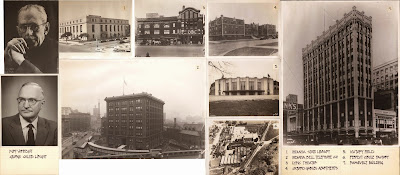After five years of working on infrastructure, lighting, air handling, drainage, and other issues at the George Rogers Clark Memorial, officials will unveil the substantial improvements at a
public event September 14, 2013.
The repairs correct significant water issues that have plagued the memorial since it opened. The National Park Service, which owns the park and memorial, chronicles the memorial building's long-standing problems on its
website:
On March 26, 1934, within six weeks of the day the memorial building was accepted by the executive committee, the members were informed that following a rain there appeared: “numerous small leaks through the terrace into the finished rooms in the basement . . . (and) there were very heavy leaks around the downspouts at the corners of the terrace.”
By Jan. 30, 1937 leaks had become so numerous that a report stated, “the disastrous results” to the building were “appalling.”
During April 1939, an inspection of the structure described the situation and “decadent conditions . .. caused by leakage, which had been allowed to exist.” This inspection found stalactites four feet in length where water seeped through the structure.
This inspection also identified the cause of the seepage problem as “damage to (the) waterproof membrane.” This was caused when granite slabs were moved into place and the concrete of the terrace surface was poured. “Improperly designed terrace drains” also were cited as a contributing factor. The report concluded, “If money were no problem, the difficulty could be corrected by removal of all the granite slabs and pebble-concrete terrace pavement and replacement of the fractured waterproof membrane.”
Money would however, be a problem. During the coming years, thousands of dollars were expended upon sealing joints and attempts to waterproof the surface of the terrace. Attempts to solve the problems were undertaken during 1941, 1943, 1952, 1958, 1965, 1973, 1978, and 1979. While some proved temporarily successful, none stopped the water seepage into the basement.
During 1998, the National Park Service was preparing for yet another waterproofing effort. The park staff at that time decided to forego the effort and, instead, seek funding for a permanent fix to the problem.
The work currently being performed essentially is the same as that recommended in the 1939 inspection report. The concrete of the terrace is being removed to the level of the waterproof membrane. The membrane then will be replaced. The stone steps and outer walls will be removed and the walls and support system repaired or replaced. When the terrace surface is replaced, a new drain system will take the place of the original “improperly designed drains.”
Above is a photo of the memorial under construction, from our Jay C. Bixby Architectural Records collection. Bixby wasn't one of the architects responsible for designing the poor drains, but he was one of the architects hired to perform repair work in the 1940s. Bixby also saved the materials related to the architectural competition for the memorial, specifications for the original building, and specifications for his later repairs, all of which can be found in his collection at the Drawings + Documents Archive.
Image: Photograph of the George Rogers Clark Memorial under construction, 1931. F. C. Hirons & F. W. Mellor, architects. Jay C. Bixby Architectural Records, Drawings + Documents Archive, Archives and Special Collections, Ball State University Libraries.
















.jpg)















